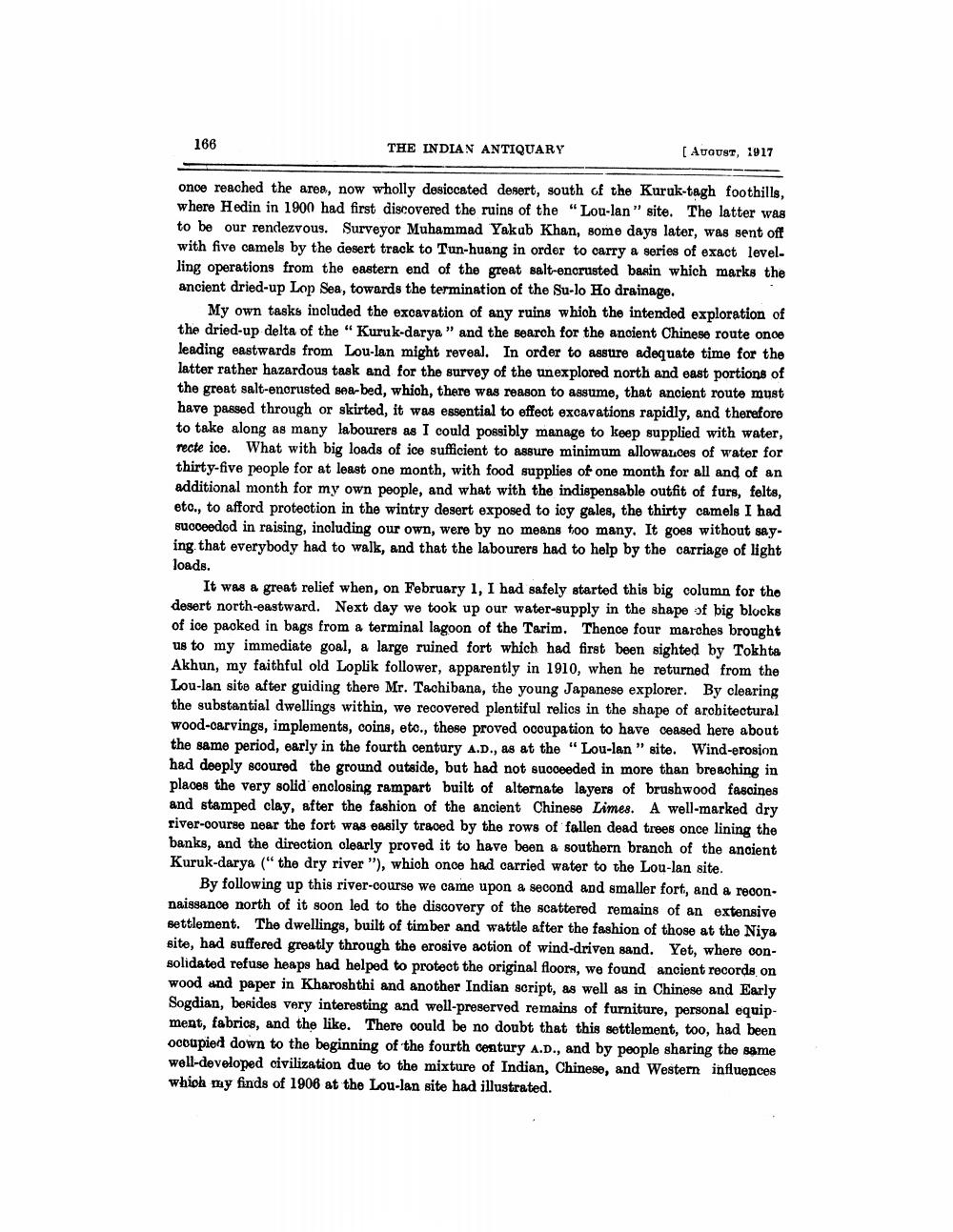________________
THE INDIAN ANTIQUARY
[ AUGUST, 1917
once reached the area, now wholly desiccated desert, south of the Kuruk-tagh foothills, where Hedin in 1900 had first discovered the ruins of the "Lou-lan" site. The latter was to be our rendezvous. Surveyor Muhammad Yakub Khan, some days later, was sent off with five camels by the desert track to Tun-huang in order to carry a series of exact levelling operations from the eastern end of the great salt-encrusted basin which marks the ancient dried-up Lop Sea, towards the termination of the Su-lo Ho drainage.
166
My own tasks included the excavation of any ruins which the intended exploration of the dried-up delta of the "Kuruk-darya" and the search for the ancient Chinese route once leading eastwards from Lou-lan might reveal. In order to assure adequate time for the latter rather hazardous task and for the survey of the unexplored north and east portions of the great salt-encrusted sea-bed, which, there was reason to assume, that ancient route must have passed through or skirted, it was essential to effect excavations rapidly, and therefore to take along as many labourers as I could possibly manage to keep supplied with water, recte ice. What with big loads of ice sufficient to assure minimum allowances of water for thirty-five people for at least one month, with food supplies of one month for all and of an additional month for my own people, and what with the indispensable outfit of furs, felts, etc., to afford protection in the wintry desert exposed to icy gales, the thirty camels I had succeeded in raising, including our own, were by no means too many. It goes without saying that everybody had to walk, and that the labourers had to help by the carriage of light loads.
It was a great relief when, on February 1, I had safely started this big column for the desert north-eastward. Next day we took up our water-supply in the shape of big blocks of ice packed in bags from a terminal lagoon of the Tarim. Thence four marches brought us to my immediate goal, a large ruined fort which had first been sighted by Tokhta Akhun, my faithful old Loplik follower, apparently in 1910, when he returned from the Lou-lan site after guiding there Mr. Tachibana, the young Japanese explorer. By clearing the substantial dwellings within, we recovered plentiful relics in the shape of architectural wood-carvings, implements, coins, etc., these proved occupation to have ceased here about the same period, early in the fourth century A.D., as at the "Lou-lan" site. Wind-erosion had deeply scoured the ground outside, but had not succeeded in more than breaching in places the very solid enclosing rampart built of alternate layers of brushwood fascines and stamped clay, after the fashion of the ancient Chinese Limes. A well-marked dry river-course near the fort was easily traced by the rows of fallen dead trees once lining the banks, and the direction clearly proved it to have been a southern branch of the ancient Kuruk-darya ("the dry river "), which once had carried water to the Lou-lan site.
By following up this river-course we came upon a second and smaller fort, and a reconnaissance north of it soon led to the discovery of the scattered remains of an extensive settlement. The dwellings, built of timber and wattle after the fashion of those at the Niya site, had suffered greatly through the erosive action of wind-driven sand. Yet, where consolidated refuse heaps had helped to protect the original floors, we found ancient records on wood and paper in Kharoshthi and another Indian script, as well as in Chinese and Early Sogdian, besides very interesting and well-preserved remains of furniture, personal equipment, fabrics, and the like. There could be no doubt that this settlement, too, had been occupied down to the beginning of the fourth century A.D., and by people sharing the same well-developed civilization due to the mixture of Indian, Chinese, and Western influences which my finds of 1906 at the Lou-lan site had illustrated.




